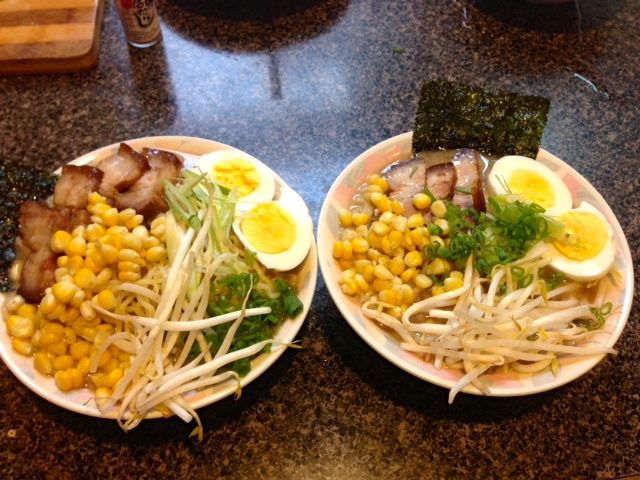Not-so-instant ramen
Until a few weeks ago, I thought that ‘ramen’ referred only to that packaged stuff notorious for sustaining students through their college years. I had no idea that ‘instant ramen’ was based off of a real Japanese dish. A friend told me about a small, locally famous ramen shop in Porter Square, Cambridge. “Give yourself some time”, she said. “You’ll be waiting in line for a while.”
Turns out there are two ramen shops in Porter Square, both of which are regarded as the best ramen in the Boston area. The one my friend was referring to is called “Yume Wo Katare.” The one I ended up going to is called “Sapporo Ramen.” Yume Wo Katare is closed over the summer. I guess its Japanese chef, who apparently has opened multiple restaurants in Japan, is visiting Japan.
Sapporo Ramen is a charming little shop hidden away in a small shopping center. It’s the size of a living room, and it’s tiny kitchen is tucked away in a corner. There are only about 7 or 8 tables, and a line usually stretches down the hallway. I have always been a big fan of instant ramen, especially the fiery Korean Shin brand. I was blown away by my first real bowl of ramen, served in a large clay bowl, filled to the brim with yellow noodles and steaming broth. Ramen looks very attractive when served with all its toppings laid out nicely. I told myself to remember to snap a picture before I dug in, but my appetite got the better of me. Caitlin reminded me, but it was too late.

The broth, brewed with pork bones and aromatics for over 10 hours, tastes amazing — a savory and salty umami heaven. The yellow wheat noodles are what the name ‘ramen’ refers to. They are made using kansui, a mix of sodium carbonate and potassium carbonate. The alkalinity of these two compounds keeps the noodles from becoming mushy when sitting in the hot broth and helps them maintain the chewiness that makes them so satisfying to munch on. On top of the broth and ramen, a number of toppings are placed. This depends on the style. The noodles I ordered had pork, beansprouts, scallions, nori (dried seaweed), corn, and half a boied egg.
The ramen was so good I finished the whole bowl, including the soup. I felt bloated afterwards, but it was worth it. During another visit I ordered double the amount of noodles and finished all of it, plus the broth, plus Caitlin’s broth. Again, worth it. Besides, it’s customary in Japanese culture to finish everything on your plate.
We were so impressed by these noodles that Caitlin and I decided to try our hand at them. I followed this recipe, which I highly recommend if you want to try making ramen from scratch. The recipe is for tonkotsu style ramen, characterized by its creamy, fat and collagen rich pork broth. The author even has a recipe for making your own ramen noodles from scratch.
I have to say, making the two bowls of ramen was one of the more challenging and stressful things I’ve done. The broth itself took three hours to prepare and involved cleaning the bones and purifying the blood from them. We used a pressure cooker to speed up the process of extracting that yummy umami flavor from the bones. The chasu required about an hour of slow simmering in a rich braising liquid (miso, soy sauce, sake, mirin, cinnamon bark, star anise, sugar, etc.) In fact, most of the sauces required were ridiculously complicated, requiring a vast number of ingredients, most of which I had never heard of before. I guess that’s where the uniquely memorable flavor comes from.
Preparing it required a lot of attention, multitasking, and care. The details mattered, from mincing the fatback small enough that it would dissolve properly (giving the broth an added creaminess) to slicing the scallions in the right shape.
After two days of preparation, it was pretty satisfying to see the finished bowls.

Attention to the details is what defines great ramen, and from experience, I can say that this dish has a very high skill cap. What I mean by that is that unlike some foods (making toast, for instance), ramen can vary greatly in its quality — from great to legendary. It’s also a dish that gives the chef lots of space for innovation, both in preparation method and choice of ingredients. There are so many styles of ramen out there, and each shop has its own signature variations that define the dish.
I plan on traveling to Japan in the not-too-distant-future to experience first-hand its culture, history, and its world-renowned food. Hopefully it’s not too naive of me to work towards perfecting a ramen that someday I’ll get to call my own. This is the beginning of my story of ramen. May it unfold one slurp at a time.